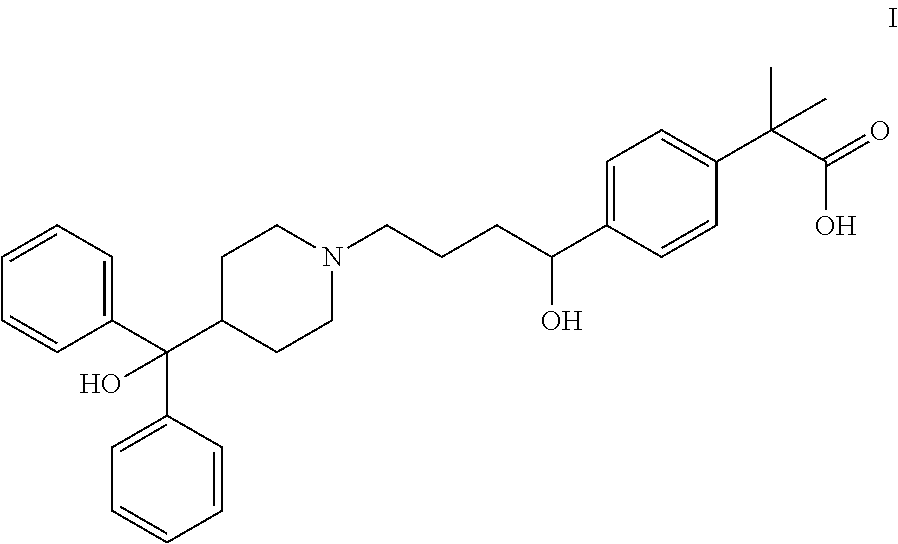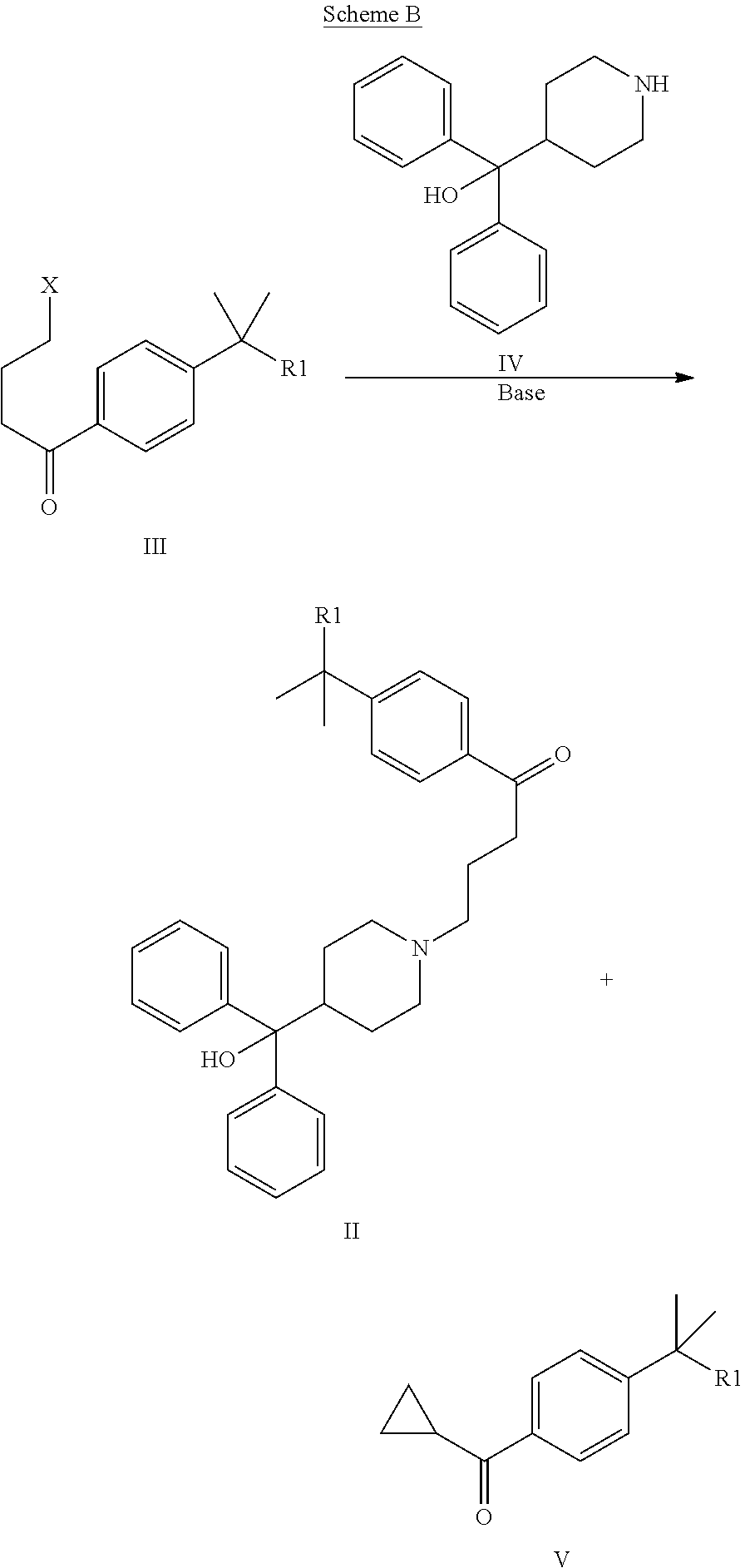Process for the preparation of fexofenadine and of intermediates used therein
- Summary
- Abstract
- Description
- Claims
- Application Information
AI Technical Summary
Benefits of technology
Problems solved by technology
Method used
Image
Examples
reference example 1
[0076]Reaction of azacyclonol (Diphenyl(piperidin-4-yl)methanol, CAS: 115-46-8) (IV) with 2-[4-(cyclopropanecarbonyl-)-phenyl]-2-methyl-propanenitrile according to the coupling conditions described in Table 2 of Wang et al. (Org. Proc. Res. and Dev. 2010, 14, 1464-68).
[0077]The table depicted below lists the reaction conditions (solvent, base, temperature) set forth in Table 2 of Wang et al. for reacting azacyclonol with a compound of formula III (X is Br, Cl, OTs; R1 is nitril) to obtain a compound of formula II-A and, as side product, a compound of formula V-A. If this nitrile by-product V-A is tested under the reaction conditions mentioned by Wang it does not react with azacyclonol to compound II-A as described below for each entry in more detail.
EntrysolventbaseT (° C.)yield II-A (%)*1THFNa2CO36002THFNaHCO36003DMFEt3N2504THFEt3N2505THFDIPA2506acetoneNaHCO36007acetoneEt3N600*The detection limit was 0.1 mol %
Entry 1
[0078]2-[4-(cyclopropanecarbonyl-)-phenyl]-2-methyl-propanenitrile...
reference example 2
[0100]Reaction of azacyclonol (Diphenyl(piperidin-4-yl)methanol, CAS: 115-46-8) (IV) with 2-[4-(cyclopropanecarbonyl-)-phenyl]-2-methyl-propanenitrile (V-A) according to coupling conditions described by Yovell et al. (J. Org. Chem. 42, 850-855, 1977, page 855) to obtain a compound of formula II-A (as indicated in WO2006 / 034092 / AMR Techn.).
a) Reaction According to Yovell
[0101]2-[4-(cyclopropanecarbonyl-)-phenyl]-2-methyl-propanenitrile of formula V-A (1.07 g, 5.0 mmol) and azacyclonol (1.34 g, 5.0 mmol, 1.0 eq.) and 2.4 ml o-xylene were added to a 25 ml 3-neck flask. p-Toluenesulfonic acid monohydrate (95 mg, 0.5 mmol 0.1 eq, CAS: 6192-52-5) were added and the mixture was heated to reflux (bath temperature about 150° C.).
[0102]Monitoring the reaction by HPLC showed about 7% product II-A after 2 hours and about 46% after 20 hours.
[0103]HPLC (AUC, Merck Chromolith Performance RP18e, A: H2O / 0.05% TFA, B: MeCN / 0.05% TFA, 10->70% B in 7 min, 4 ml / min, 40° C., UV: 210 nm Rt=4.11 min
b) Use ...
example 1
[0109]Catalyst evaluation based on a general procedure for preparing 2-[4-[4-[4-[hydroxy(diphenyl)methyl]-1-piperidyl]butanoyl]phenyl]-2-methyl-propanenitrile (480.7 g / mol) of formula II-A using azacyclonol (Diphenyl(piperidin-4-yl)methanol, CAS: 115-46-8) of formula IV, 2-[4-(cyclopropanecarbonyl-)-phenyl]-2-methyl-propanenitrile of formula V-A and different salts as catalysts, partly additionally a salt with different amounts:
[0110]Azacyclonol (2.67 g, 10.0 mmol) and 2-[4-(cyclopropanecarbonyl-)-phenyl]-2-methyl-propanenitrile of formula V-A (2.13 g, 10 mmol) were placed in 25 ml 3-neeked flask. Toluene (0.3 ml, 5 wt %) and the catalyst as specified below in the single experiments were added and the mixture was heated to 150° C. and stirred for 20 h. Conversion was followed by HPLC and LC-MS (vide infra). Samples were taken at 150° C. after 2 h and 20 h. HPLC (AUC, Merck Chromolith Performance RP18e, A. H2O / 0.05% TFA, B: MeCN / 0.05% TFA, 10->70% B in 7 min, 4 ml / min, 40° C., UV: 21...
PUM
 Login to View More
Login to View More Abstract
Description
Claims
Application Information
 Login to View More
Login to View More - R&D
- Intellectual Property
- Life Sciences
- Materials
- Tech Scout
- Unparalleled Data Quality
- Higher Quality Content
- 60% Fewer Hallucinations
Browse by: Latest US Patents, China's latest patents, Technical Efficacy Thesaurus, Application Domain, Technology Topic, Popular Technical Reports.
© 2025 PatSnap. All rights reserved.Legal|Privacy policy|Modern Slavery Act Transparency Statement|Sitemap|About US| Contact US: help@patsnap.com



